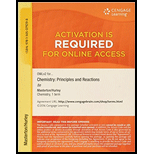
For the following reactions, predict whether the pressure of the reactants or products increases or remains the same when the volume of the reaction vessel is increased.
(a)
(b)
(c)
Want to see the full answer?
Check out a sample textbook solution
Chapter 12 Solutions
CHEMISTRY:PRIN.+REACTIONS-OWLV2 ACCESS
- Show that the complete chemical equation, the total ionic equation, and the net ionic equation for the reaction represented by the equation KI(aq)+I2(aq)KI3(aq) give the same expression for the reaction quotient. KI3 is composed of the ions K+ and I3-.arrow_forwardAt a certain temperature, K=0.29 for the decomposition of two moles of iodine trichloride, ICl3(s), to chlorine and iodine gases. The partial pressure of chlorine gas at equilibrium is three times that of iodine gas. What are the partial pressures of iodine and chlorine at equilibrium?arrow_forwardWrite the expression for the equilibrium constant and calculate the partial pressure of CO2(g), given that Kp is 0.25 (at 427 C) for NaHCO3(s) NaOH(s) + CO2(g)arrow_forward
- Consider the system 4NH3(g)+3O2(g)2N2(g)+6H2O(l)H=1530.4kJ (a) How will the concentration of ammonia at equilibrium be affected by (1) removing O2(g)? (2) adding N2(g)? (3) adding water? (4) expanding the container? (5) increasing the temperature? (b) Which of the above factors will increase the value of K? Which will decrease it?arrow_forwardAt a temperature of 60 C, the vapor pressure of water is 0.196 atm. What is the value of the equilibrium constant KP for the transformation at 60 C? H2O(l)H2O(g)arrow_forwardSuppose a reaction has the equilibrium constant K = 1.3 108. What does the magnitude of this constant tell you about the relative concentrations of products and reactants that will be present once equilibrium is reached? Is this reaction likely to be a good source of the products?arrow_forward
- For the reactionH2(g)+I2(g)2HI(g), consider two possibilities: (a) you mix 0.5 mole of each reactant. allow the system to come to equilibrium, and then add another mole of H2 and allow the system to reach equilibrium again. or (b) you mix 1.5 moles of H2 and 0.5 mole of I2 and allow the system to reach equilibrium. Will the final equilibrium mixture be different for the two procedures? Explain.arrow_forwardWhat is the law of mass action? Is it true that the value of K depends on the amounts of reactants and products mixed together initially? Explain. Is it true that reactions with large equilibrium constant values are very fast? Explain. There is only one value of the equilibrium constant for a particular system at a particular temperature, but there is an infinite number of equilibrium positions. Explain.arrow_forwardConsider the system 4NH3(g)+3O2(g)2N2(g)+6H2O(l)H=1530.4kJ (a) How will the amount of ammonia at equilibrium be affected by 1. removing O2(g)? 2. adding N2(g)? 3. adding water? 4. expanding the container at constant pressure? 5. increasing the temperature? (b) Which of the above factors will increase the value of K? Which will decrease it?arrow_forward
- Write equilibrium constant expressions for the following reactions. For gases, use either pressures or concentrations. (a) 2 H2O2(g) 2 H2O(g) + O2(g) (b) CO(g) + O2g CO2(g) (c) C(s) + CO2(g) 2 CO(g) (d) NiO(s) + CO(g) Ni(s) + CO2(g)arrow_forwardFor the reaction N2(g)+3H2(g)2NH3(g) show that Kc = Kp(RT)2 Do not use the formula Kp = Kc(RT)5n given in the text. Start from the fact that Pi = [i]RT, where Pi is the partial pressure of substance i and [i] is its molar concentration. Substitute into Kc.arrow_forwardIn a solution with carbon tetrachloride as the solvent, the compound VCl4. undergoes dimerization: 2VCl4V2Cl8 When 6.6834 g VCl4. is dissolved in 100.0 g carbon tetrachloride, the freezing point is lowered by 5.97C. Calculate the value of the equilibrium constant for the dimerization of VCl4 at this temperature. (The density of the equilibrium mixture is 1.696 g/cm3, and Kf = 29.8C kg/mol for CCl4.)arrow_forward
 Chemistry & Chemical ReactivityChemistryISBN:9781133949640Author:John C. Kotz, Paul M. Treichel, John Townsend, David TreichelPublisher:Cengage Learning
Chemistry & Chemical ReactivityChemistryISBN:9781133949640Author:John C. Kotz, Paul M. Treichel, John Townsend, David TreichelPublisher:Cengage Learning Chemistry: Principles and PracticeChemistryISBN:9780534420123Author:Daniel L. Reger, Scott R. Goode, David W. Ball, Edward MercerPublisher:Cengage Learning
Chemistry: Principles and PracticeChemistryISBN:9780534420123Author:Daniel L. Reger, Scott R. Goode, David W. Ball, Edward MercerPublisher:Cengage Learning Introductory Chemistry: A FoundationChemistryISBN:9781285199030Author:Steven S. Zumdahl, Donald J. DeCostePublisher:Cengage Learning
Introductory Chemistry: A FoundationChemistryISBN:9781285199030Author:Steven S. Zumdahl, Donald J. DeCostePublisher:Cengage Learning Chemistry & Chemical ReactivityChemistryISBN:9781337399074Author:John C. Kotz, Paul M. Treichel, John Townsend, David TreichelPublisher:Cengage Learning
Chemistry & Chemical ReactivityChemistryISBN:9781337399074Author:John C. Kotz, Paul M. Treichel, John Townsend, David TreichelPublisher:Cengage Learning Chemistry: The Molecular ScienceChemistryISBN:9781285199047Author:John W. Moore, Conrad L. StanitskiPublisher:Cengage Learning
Chemistry: The Molecular ScienceChemistryISBN:9781285199047Author:John W. Moore, Conrad L. StanitskiPublisher:Cengage Learning Chemistry by OpenStax (2015-05-04)ChemistryISBN:9781938168390Author:Klaus Theopold, Richard H Langley, Paul Flowers, William R. Robinson, Mark BlaserPublisher:OpenStax
Chemistry by OpenStax (2015-05-04)ChemistryISBN:9781938168390Author:Klaus Theopold, Richard H Langley, Paul Flowers, William R. Robinson, Mark BlaserPublisher:OpenStax





